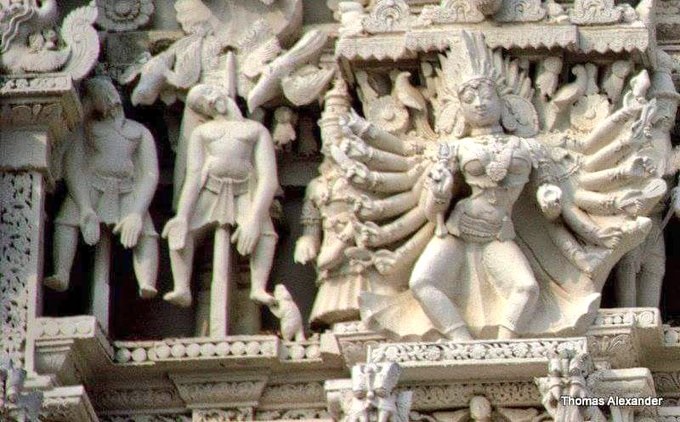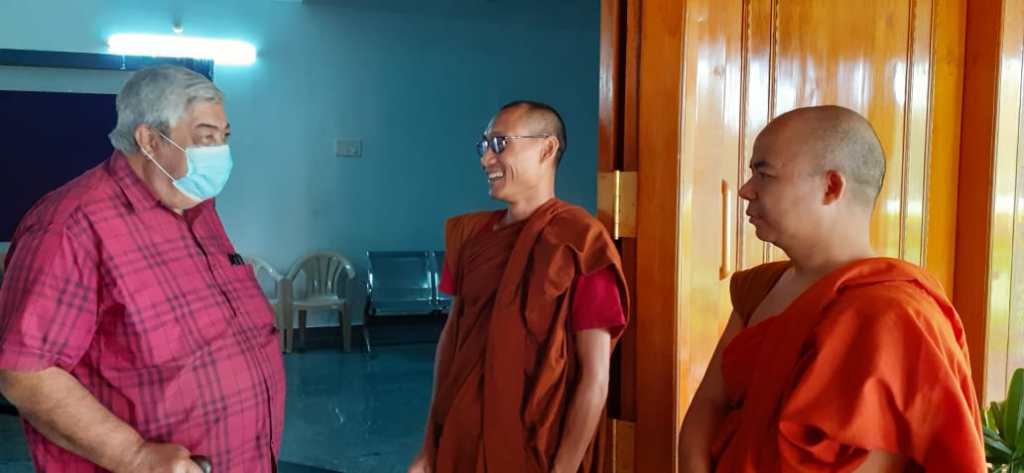Buried temple found during sand mining and digging, that was reportedly covered by the sand dunes due to the change of Pennar River course!

Buried temple found during the sand mining activities at Pennar River bed: An ancient temple of Sri Nageswara Swamy, constructed approximately 200 years ago and remained buried under the sand of Penna river, at Perumallapadu of Chejarala Mandal of Nellore district in Andhra Pradesh, for almost 80 years now, has been unearthed. While it remains debated whether or not the temple is 200 or 300 years old, a few things are certain. According to Ancient Origins, the temple is dedicated to Lord Nageswara, an avatar of the God Shiva. The temple, which according to the legend was consecrated by Lord Parasurama, an avatara of Lord Vishnu, got buried over a long period of time as the river Penna changed its course[1]. The brick structure may have got submerged in sand dunes probably after the 1850 floods, Archaeology Assistant Director Ramasubba Reddy felt[2]. He said the higher officials would inspect the site soon and decide on the excavation and preservation works. The officials of the Archaeology and Endowments departments said they would work out a plan to restore the temple respecting the sentiments of the villagers. Thus, the change of course of Penna River has been an important event in the history of geology or geoarchaeology for study. The related experts could have gone there to study, but, nothing appeared thereafter.

Another version reported that the youth of the village started digging to find the buried temple: In June 2020, this was the news and many were interestingly observing as to what would happen next. The villagers claimed, because of the pandemic, they were spending time at their homes, but some youth had gone to search for the buried temple and started digging[3]. The temple saw the light of the day during sand excavations carried out by villagers of Perumallapadu of Chejarala Mandal of Nellore district in Andhra Pradesh[4]. According to reports, the villagers became curious after some locals stumbled on a few small structures of the temple when they took up digging recently in sand reaches[5]. But, it was actually, the sand mining workers suddenly came across the structure, while they were removing sand with earth-moving equipments. Of course, the sand mining activities have been going on for many years, as this has been a crores-producing profitable business. As they kept digging deep, they could unearth an entire temple of ancient times[6]. So whether the temple reappeared due to the intentional digging of the village youth or the sand mining, the fact remains about the buried temple.

Pennar River changed course and the temple was buried to disappear: Amused by their discovery, the local residents made enquiries in the surrounding villages about the historical significance of this temple. During their research, some village elders confirmed the existence of the temple on the river bed several decades back. The temple was well known two-three generations ago. It was filled up by the sand almost 80 years ago, locals said[7]. Some enthusiastic villagers collected money and started searching for this temple. It took almost one day to find out the pinnacle of the temple[8]. But it got gradually covered under a sheet of sand which used to get deposited every time Penna river received floods during the rainy season[9]. And that explained how the existence of the ancient temple was completely erased. That is during the course of time, probably after three generations, even history is forgotten. Nowadays, none is able to remember their great-grand fathers and mothers, except some old people might remember. Under such circumstances, it is important that we should record the memories of our elders, particularly, who have been above 70 to 100, as they could give first-hand information about the events that happened from 1900 to 1960. Nowadays, it has to be noted that even the near-past events are interpreted differently, ccording to the whims and fancies of the ideologists.

What villagers of Perumallapadu in Chejarla Mandal said: “Along with the Sri Nageswara Swamy temple, two other temples — Kotiteertham temple and Sangam Sivalayam — in the district were constructed at the same time[10]. Thus, they say that 108 temples were built by Parasurama and so on. All the temple rituals including daily pooja to the deity used to be performed at Sri Nageswara Swamy temple 200 years ago[11]. But it gradually got covered under sand and completely vanished[12]. Now, some youngsters dug up the sand only to accidentally rediscover the temple. We have plans to refurbish the temple to renew daily pooja rituals. We have already contacted priests and based on their advice, we will take a decision,” villagers of Perumallapadu in Chejarla Mandal said[13]. “Then one day, a man Galipala Sudarsan initiated to bring this temple out. The sanctum sanctorum is much deeper and the area in which it was found is Mukha Mantapam. We are now planning to re-construct the temple but where it should be made is the dilemma. We have to check the condition and status of Lord Shiva’s idol. We will seek advice from the elders and the priests,” he added[14].

Now again the temple has been forgotten: As the news of the Nageswara Swamy temple being unearthed in Perumallapadu village spread like wildfire, people from many neighbouring villages flocked to the area to catch a glimpse of it and began offering prayers. However, as the news shot up and started getting the attention of many, in the same way, some vested interested groups wanted to huss up and silence the issue. First, the ASI and state Archaeological authorities might get into problems, as they could not give any permission for such activities taking place near to the sites at a distance of 100 kms. Note that the Archaeology Assistant Director Ramasubba Reddy said the higher officials would inspect the site soon and decide on the excavation and preservation works. The officials of the Archaeology and Endowments departments said they would work out a plan to restore the temple respecting the sentiments of the villagers. But, what happened thereafter is not known and there has not been any report by the archaeological department. Therefore, the local authorities, immediately sprung into action and started stopping the people going there, doing pujas etc., they also stopped youth and others by collecting funds and initiative to renovate the temple.

Historians, archaeologists and related experts can take action to know the follow-up proceedings?: Moreover, it is also claimed that some trust own the area that has been subjected to sand mining. In other words, others cannot come there, enter or encroach to carry out such activities. Moreover, news is spread, even if renovation is done, because of the depth, the temple would be again buried under the sands. Yet, some other argued that the temple itself own many lands and therefore, none need to give any funds, if the authorities, properly implement legal procedure, everything would be carried out peacefully, as the local village people assert. But, the news has now forgotten and none talks about the temple. Above all, it is not known what the historians, archaeologists and other experts who used make a hue and cry about the losing importance of history, have done in this regard.
© K. V. Ramakrishna Rao
16-04-2023
[1] The Hindu, Historical temple unearthed in Nellore, S Murali, June 16, 2020 11:25 pm | Updated June 18, 2020 02:11 pm IST.
[2] https://www.thehindu.com/news/national/andhra-pradesh/historic-temple-unearthed-in-nellore/article31846032.ece
[3] Sakshi Post, 200-Year-Old Temple Buried In Penna River Bed Unearthed, Sakshi Post, 17 Jun, 2020 18:48 IST|
[4] https://m.sakshipost.com/news/andhrapradesh/villagers-ap-unearth-200-year-old-temple-buried-penna-sand-120302
[5] News18.com, Ancient Lord Shiva Temple Found During Sand Mining in Andhra’s Nellore, Last Updated: JUNE 17, 2020, 16:04 IST.
[6] https://www.news18.com/news/buzz/ancient-lord-shiva-temple-found-during-sand-mining-in-andhras-nellore-2674173.html
[7] ANI, Ancient Lord Nageswara temple unearthed in Nellore, | Updated: Jun 17, 2020 09:48 IST.
[8] https://www.aninews.in/news/national/general-news/ancient-lord-nageswara-temple-unearthed-in-nellore20200617094851/
[9] Republic World, Ancient Lord Nageswara Temple Unearthed In Andhra Pradesh’ Nellore District During Mining, City News, Written By Pritesh Kamath. Last Updated: 17th June, 2020 15:40 IST.
[10] https://www.republicworld.com/india-news/city-news/nageswara-temple-shiva-temple-nellore-andhra-pradesh-chejarla-mandal.html
[11] Archaeology-network, Historical Shiva temple found during sand mining in Andhra Pradesh\s Nellore District, Tann, 2020-06-20.
[12] https://archaeonewsnet.com/2020/06/historical-shiva-temple-found-during.html
[13] The hitavada, Ancient Lord Nageswara temple unearthed in Nellore, Date :18-Jun-2020.
[14] https://www.thehitavada.com/Encyc/2020/6/18/Ancient-Lord-Nageswara-temple-unearthed-in-Nellore.html
Filed under: archaeological remains, archaeological sites, archaeological survey of India, archaeology, buried temple, historicity, historiography, historiosophy, history, history usage, history useful, history useless, idol, pennar, pennar river, Perumallapadu, sand, shiva, spirituality, Sri Nageswara Swamy,, submerged, submerged sites, submerged temple, temple, temple desecration, temple ruins | Tagged: Andhra, ASI, buried temple, change of course, change of course of river, geo-archaeology, geoarchaeology, geography, geology, nellore, pennar, pennar river, Perumallapadu, river, river bank, river course, sand, sand dune, temple buried | Leave a comment »








































